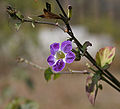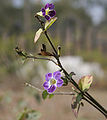- Asystasia gangetica
-
Chinese Violet 
Asystasia gangetica from Kalepolepo, Maui Asystasia gangetica micrantha from Amanzimtoti, South Africa Scientific classification Kingdom: Plantae (unranked): Angiosperms (unranked): Eudicots (unranked): Asterids Order: Lamiales Family: Acanthaceae Genus: Asystasia Species: A. gangetica Binomial name Asystasia gangetica
(L.) T.AndersonSynonyms - Asystasia parvula C.B.Clarke
- Asystasia querimbensis Klotzsch
- Asystasia pubescens Klotzsch
- Asystasia subhastata Klotzsch
- Asystasia quarterna Nees
- Asystasia scabrida Klotzsch
- Asystasia floribunda Klotzsch
- Asystasia coromandeliana Nees
- Justicia gangetica L.
- Asystasia acuminata Klotzsch
- Asystasia coromandeliana Nees var. micrantha Nees
- Asystasia multiflora Klotzsch
- Asystasia ansellioides C.B.Clarke var. lanceolata Fiori
- Asystasia podostachys Klotzsch[1]
Asystasia gangetica is a species of plant in the Acanthaceae family. It is commonly known as the Chinese Violet, Coromandel[2] or Creeping Foxglove[3]. In South Africa this plant may simply be called Asystasia.[4]
 From Hyderabad, India
From Hyderabad, India
Contents
Description
This plant is a spreading herb or groundcover, reaching 600 mm in height[3][4] or up to 1 m if supported[5]. The stems root easily at the nodes.[3] The leaves are simple[3] and opposite[5]. The fruit is an explosive capsule which starts out green in colour, but dries to brown after opening.[5]
Subspecies
- A. g. gangetica, has larger (30–40 mm long) blue or mauve flowers.[5]
- A. g. micrantha (Nees) Ensermu, has smaller (up to 25 mm long.[5]) white flowers with purple markings on the lower lip.[4]
Distribution
Widespread throughout the Old World Tropics, and introduced into tropical Americas[6] and Hawaii, where it has become naturalized[2]. Both subspecies of this plant have been introduced to Australia where A. g. micrantha is on the National Environmental Alert List and must be reported when found.[5] The original range of the subspecies is unclear,[5] but it is likely that A. g. gangetica was limited to Asia, and A. g. micrantha was limited to Africa.[3]
Uses
In some parts of Africa, the leaves are eaten as a vegetable and used as an herbal remedy in traditional African medicine.[7] The leaves are used in many parts of Nigeria for the management of asthma, and scientific investigation has shown some basis for this use.[8] It is also used as an ornamental plant.[3]
Ecological Significance
This is an important plant for honeybees, butterflies and other insects.[3][4] In southern Africa there are at least six species of butterfly that use A. g. micrantha as a larval foodplant; Junonia oenone, Junonia hierta, Junonia natalica, Junonia terea, Protogoniomorpha parhassus and Hypolimnas misippus.[9] The vigorous growth of A. g. micrantha in tropical regions[3] makes it a weed which can smother certain indigenous vegetation where it has been introduced.[5]
Gallery
References
- ^ Jstor Plant Science, Asystasia gangetica synonyms: http://plants.jstor.org/taxon/synonymy/Asystasia.gangetica, retrieved 28 July 2010
- ^ a b Plants of Hawaii: Asystasia gangetica: http://www.hear.org/starr/images/species/?q=asystasia+gangetica&o=plants, retrieved 28 July 2010
- ^ a b c d e f g h South African National Biodiversity Institute: Asystasia gangetica: http://www.plantzafrica.com/plantab/asystasiagan.htm, retrieved 28 July 2010
- ^ a b c d Pooley, E. (1998). A Field Guide to Wild Flowers; KwaZulu-Natal and the Eastern Region. ISBN 0-620-21500-3.
- ^ a b c d e f g h Weed Identification, Australia: http://www.weeds.org.au/cgi-bin/weedident.cgi?tpl=plant.tpl&state=&s=&ibra=all&card=H34, retrieved 28 July 2010.
- ^ Jstor Plant Science, Asystasia gangetica: http://plants.jstor.org/taxon/Asystasia.gangetica, retrieved 28 July 2010.
- ^ Grubben, G.J.H. & Denton, O.A. (2004) Plant Resources of Tropical Africa 2. Vegetables. PROTA Foundation, Wageningen; Backhuys, Leiden; CTA, Wageningen.
- ^ . doi:10.1016/S0378-8741(03)00227-7.
- ^ Williams, M. (1994). Butterflies of Southern Africa; A Field Guide. ISBN 1-86812-516-5.
External links
Categories:- Asystasia
- Flora of Africa
- Medicinal plants
Wikimedia Foundation. 2010.




